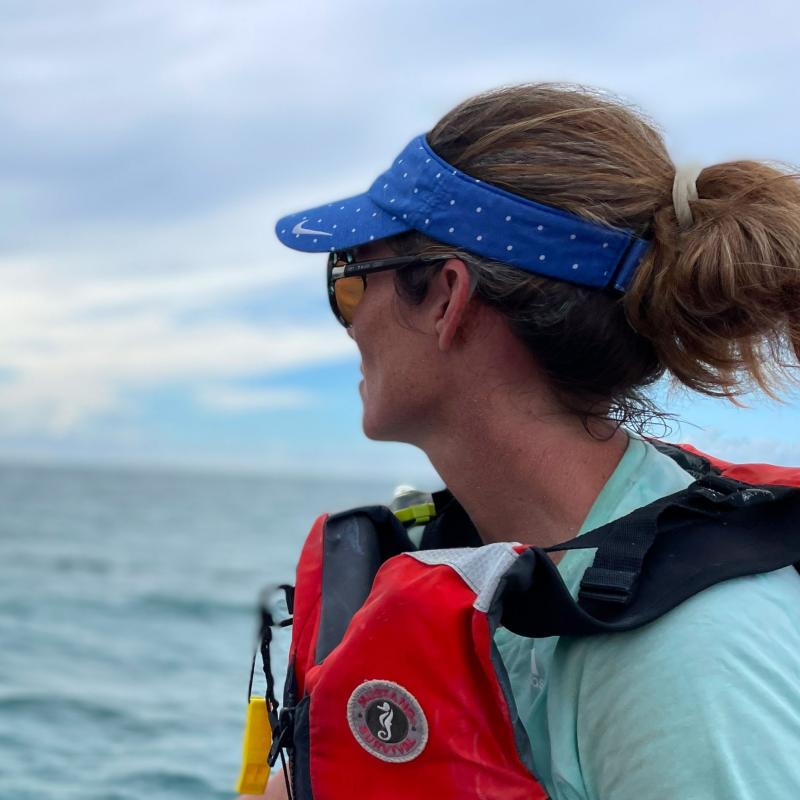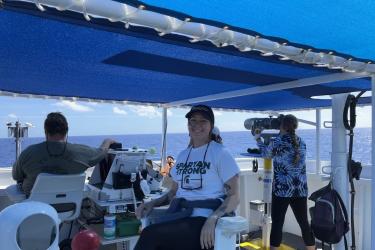Papahānaumokuākea Marine National Monument encompasses some of the most remote islands on earth. Would such an isolated place even show evidence of a year-long absence of human beings? In 2020, our protected species research teams relied solely on partnerships to conduct the field season in Papahānaumokuākea for the first time in nearly 4 decades, as countless activities came to a halt worldwide. This year, we triumphantly return to remote field camps throughout Papahānaumokuākea. Some of the biologists have worked for years at these field camps, studying Hawaiian monk seals or marine turtles. What will have changed after a year away? Our new, budding biologists have patiently awaited this date—how will they feel when finally reaching their remote island homes?
While they are eager to contribute to decades of research, the camps are also integrating the Huli ʻia into their activities for the first time this season. Contributing to these seasonal observations will serve as a bridge between science and culture.
Team Lalo (French Frigate Shoals)
Lalo may have seen the most dramatic environmental changes in recent years—some of its tiny islets have disappeared with shifting seas, some reef and island areas were destroyed by Hurricane Walaka in 2018, and aging infrastructure from the past military outpost presents an ever-changing landscape on the human-augmented Tern Island. We are particularly interested to check on transformations at Lalo after a year away.
Our marine turtle research team, deployed in March, noted exceptionally high numbers of Hawaiian green sea turtles nesting on Tern Island. They regularly rescued animals caught in the island’s degraded seawall. Our Hawaiian monk seal research team joined the Lalo camp in July. They were happy to find several healthy weaned pups. This site is notorious for high shark predation, making juvenile survival difficult. They have already begun translocating weaned pups from high to low-risk areas for sharks.
Team Kamole (Laysan Island)
Kamole is the largest island in Papahānaumokuākea, requiring a hot 5-mile walk through deep sand to fully survey the island. Team leader, Marjorie Cox, was worried that after a year away from camp, she might not remember all the survey sections around the island. Once on the island, she happily found that it all came flooding back like she’d never left.
The biggest excitement for the Kamole team was sighting seal WK04, “Maiapilo,” who we took for rehabilitation as a malnourished pup in 2018. After a season of nutrition and care at The Marine Mammal Center’s Ke Kai Ola Hawaiian Monk Seal Hospital in Kona, we returned Maiapilo to Kamole in 2019. Now she is a robust subadult, thriving in her natal habitat.
While little appeared different about the island itself, we noticed the amount of marine debris on the beaches. Earlier this spring, the Papahānaumokuākea Marine Debris Project had performed a massive debris clean-up, and their efforts were visible (or rather, invisible) on the clean beaches.
Team Kapou (Lisianski Island)
The entire Kapou team consisted of new biologists embarking on their first season of research in Papahānaumokuākea. After a long day establishing camp on the small island, their first night may have been a little less restful than they’d hoped: On the night we deployed the Kapou camp, we received news of an 8.2-magnitude earthquake in Alaska and tsunami watch for Hawaiʻi. The ship was still in the area if we needed to evacuate. Luckily, the National Weather Service quickly downgraded the tsunami watch, allowing our tired campers to relax. This first-timer team was particularly struck by the beauty of the sunset over the vast horizon and amazed by the stars visible so far from the light pollution of civilization.
While the island may not notice a one-year absence of a small team of people, our research certainly did. One key job of our monk seal biologists is tagging new seal pups with long-lasting identification tags that allow the seals to be monitored throughout their lives. This year, the teams found an entirely untagged cohort of seals born in 2020. Their first objective was to tag as many of the weaned seal pups and juvenile seals as possible.
Team Manawai (Pearl and Hermes Reef)
Manawai is an atoll of vast coral reefs and water channels. Visually, it is a pallet of vivid blues dotted by tiny islets—only 80 acres of land surrounded by nearly 200,000 acres of reef. Team Leader Paige Mino missed those blues, saying she was thrilled to be back at her “second home” after a long year away.
Reaching the campsite at Southeast Island, the team was struck by the amount of verbesina (Verbesina encelioides)—its yellow flowers blanketed nearly the entire islet. This invasive plant creates concerns for bird habitat. Another invader has also been increasing at Manawai—a new species of Chondria algae was discovered at this atoll in recent years. Diver surveys earlier this year confirmed the threat is growing. Our Manawai team will take extra precautions while working in the atoll this summer by using special decontamination protocols to be sure none of the algae is moved beyond the atoll.
Team Hōlanikū (Kure Atoll)
Hōlanikū, the furthest atoll in the Northwestern Hawaiian Islands (about 1,250 miles from Honolulu), was our last stop on this research cruise, and the last camp we deployed. Team Hōlanikū was abuzz with anticipation when they finally arrived at the atoll, having spent 10 days on the ship en route to their new island home and many hot days helping set up the other camps.
This small team consists of just two NOAA biologists, both new to Papahānaumokuākea and monk seal research, but they would not be on the island alone. Upon landing, they were greeted by the biologists of the Kure Atoll Preserve with a special oli (traditional chant), welcoming them to the island. With such helpful partners, tour team set up and settled in quickly. New team member, Megan Ely, aptly summed up this season’s sentiments—after last year’s false start, she is thrilled to finally get into the field and put 2 years of training to use for conservation science!
We wish all of our field teams a safe and scientifically fruitful season in Papahānaumokuākea Marine National Monument. We look forward to learning about their experiences and sharing in their observations as a way to connect the field scientists in Papahānaumokuākea with the community back home.





